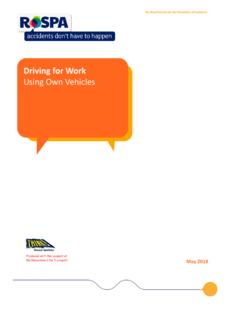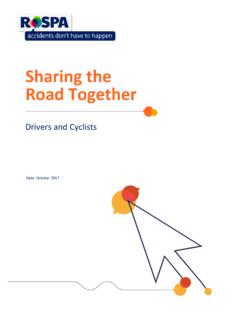Transcription of Teaching Road Safety: A Guide for Parents - RoSPA
1 Teaching road safety : A Guide for Parents Produced with the support of Department for Transport Teaching road safety : A Guide for Parents 2 Contents Introduction 3 Toddlers 4 Children aged 5-7 5 Children aged 8-11 9 Young people aged 11-15 13 Teaching road safety : A Guide for Parents 3 Introduction road safety is a great subject in which to engage children and young people. It s a subject even the youngest children know something about because everyone uses the roads, whether driving, walking, or travelling as a passenger. Unfortunately, this comes at a price, which includes people being killed and injured. However, road deaths and injuries are not inevitable. The last few decades have demonstrated that effective and comprehensive road safety strategies can reduce the number of people killed or injured on the road , despite increasing traffic.
2 Walking and cycling to school are an important part of the government s active travel agenda and help build daily exercise into our lives, resulting in health and environmental benefits. Parents and carers play an important role in preparing children to become independent travellers. This Guide provides advice on what age specific road safety information children should be taught and simple techniques for doing this. A survey commissioned by The Royal Society for the Prevention of Accidents ( RoSPA ) of Parents of primary school children found that less than half had received any road safety education training within the last 12 months in school, meaning that in many cases, road safety education becomes the responsibility of Parents . For those children who did receive some road safety education it is still vital that Parents build on this, reinforce the learning and set a good example. Encouragingly, the survey also revealed that more than half of Parents felt that they were best placed to teach their child road safety skills.
3 road safety is best taught in a practical setting meaning that Parents are ideally placed when walking their children to school to discuss road safety topics such as safe and dangerous places to cross the road . Children often mimic the behaviour of their Parents and carers, so it is vital to be consistent and put into practice safe crossing techniques. The Guide focuses primarily on Teaching these skills to children aged between 4 and 11, although there is some advice for younger and older children. Teaching road safety : A Guide for Parents 4 Toddlers When your child first starts to walk with you, talk to them about how they must always hold hands with a grown-up that they know, walking on the side of the pavement furthest away from traffic. You should make sure that hand-holding is the number one rule that your child always follows when walking near the road . If your child is likely to pull away from you, it may be advisable to use safety reigns or a wrist strap.
4 At this age, you will need to speak simply about road safety in a way that your child can understand. If you use words such as kerb, remember to explain what that is. Even at a very early age, you can explain how zebra and pedestrian crossings work. You can make pressing the button and waiting for the green man into a game. Talk about bright and dull colours and which are best seen at night. You could also show your child clothing with reflective strips and how the material shines at night when a light is shone on it. Key messages Difference between footpath and the road How to walk with a grown-up who they know and hold hands near the road Introduce Stop, Look, Listen and Think Introduce safer crossing places Be bright be seen The Department for Transport has resources that you can use: Teaching road safety : A Guide for Parents 5 Children aged 5-7 (Key Stage 1) Children are never too young to start learning about how to cross the road safely, how they should walk on the pavement and how to behave safely near the road and around traffic.
5 They are more likely to learn when out on the road , rather than in a classroom or through talking about road safety at home. Bear in mind that younger children might not understand that different situations require different responses and behaviours. For example, if you do not stop at the kerb when crossing the road to search for traffic because it is clearly an empty road and continue directly into the road , your child may not understand that they need to actually look before stopping for the traffic. At this age, children should always be accompanied by and hold hands with an adult they know around roads, particularly when they are crossing the road . Although the onus is on the motorist to look out for pedestrians, it can be difficult for motorists to see smaller children, particularly when reversing, so take extra care. Never let your child go near a road alone, even with an older child.
6 If your hands are full, you can ask your child to hold onto your shopping bag or a pushchair handle. Children at this age cannot accurately judge the speed of traffic and safe gaps in traffic in the way that adults can and should not be left unsupervised to cross even quiet roads alone. Key messages How pedestrians walk safely on the pavement and vehicles use the road How to walk with an adult who they know and hold hands when walking near the road Safer crossing places and how to use them The Stop, Look, Listen and THINK sequence. How pedestrians walk on the pavement and vehicles travel on the road Places where it is not safe to cross the road , The Department for Transport has Teaching resources that you can use: Teaching road safety : A Guide for Parents 6 Driveway safety A key area of concern regarding children s road safety is surprisingly at the child s own home. RoSPA is aware that, since 2001, at least 39 children have been killed on or near their home driveway.
7 25 of these deaths were caused by a reversing vehicle, and some were caused when the handbrake was accidentally released. Despite these statistics, RoSPA has found that 68% of Parents believe it is unlikely that their child would ever be injured by a vehicle entering or leaving the driveway. There is reduced visibility of children when reversing off a drive, so it is best to reverse onto the drive when parking, so you can drive off forward when you leave. Also, make sure to check that children have not followed you outside of the house without you realising, and monitor children who may be excited to greet a visitor whilst their car is still manoeuvring. It is vital to teach children about the dangers of driveways, both at home, and when out walking. Crossing the road You may think that crossing the road is easy, but for a child it is much more difficult. This is because crossing the road involves many tasks- identifying a safe place to cross the road whilst considering parked cars, junctions and kerbs, paying attention to traffic, looking and listening and focussing on the need to walk rather than run across the road .
8 Therefore, it is a good idea to take your child out near a quiet road to begin to practice crossing the road safely. The Stop, Look, Listen and Think sequence Children aged 5-6 can begin to learn the Stop, Look, Listen and Think sequence. Stop: when you approach a crossing, STOP before you come to the edge of the pavement Look: LOOK for cars, bikes, lorries and other vehicles by looking right, left and right again Listen: LISTEN for vehicles too. You may be able to hear them before you see them Think: is there enough time for you to cross the road safely? Think! Stop Look Listen Teaching road safety : A Guide for Parents 7 Remind your child that if they are wearing a hood, they will need to remove this when crossing the road as it could restrict their ability to see and hear traffic approaching. Although it is very important to teach children about the roads that they use almost daily, such as in the local area and travelling to school, it is important to teach them about the different types of roads that they may not encounter so often, such as those on holiday or on a day trip.
9 Your child will need to learn the differences between for example the local roads and a very busy road in front of a beach, or in a busy city centre and rural roads with lots of hidden bends and no pavements. If you are travelling abroad, you can show and explain to your child that in some countries, vehicles travel on the other side of the road . road signs and crossings At this age, you can start to talk about road signs and crossings. When you are walking with your child, you can talk about and point out: Traffic lights, and what the different signals mean Yellow or white zig zag road markings: explain to your child that cars and other vehicles are not allowed to park anywhere on these lines. They are used to allow young people to see clearly right and left when they are crossing the road . They may see these markings on the road near their school. Speed limit signs, such as the 20mph sign: explain that these signs tell drivers to reduce their speed to 20mph or less because there is likely to be pedestrians on the pavement and crossing the road .
10 The lower speed helps drivers and pedestrians to be more aware of one another. This is a good opportunity to mention that circular signs give motorists an order. Children crossing sign: explain to your child that this sign indicates to drivers that they should be watching for children waiting to cross the road in the area. Teaching road safety : A Guide for Parents 8 Be safe, be seen It is also important to teach children of all ages about the need to be visible on the roads, and this is particularly important as the evenings get darker at the end of autumn and throughout winter. You will need to encourage your child to wear clothes that make them visible to motorists. Many coats and school bags have reflective strips to make your child more visible to motorists. It is vital that your child understands the need to see and be seen, and how difficult it can be for motorists to see them. You can explain to them how their clothing can affect their visibility to other road users and how it can affect their ability to see and hear what is going on around them.










